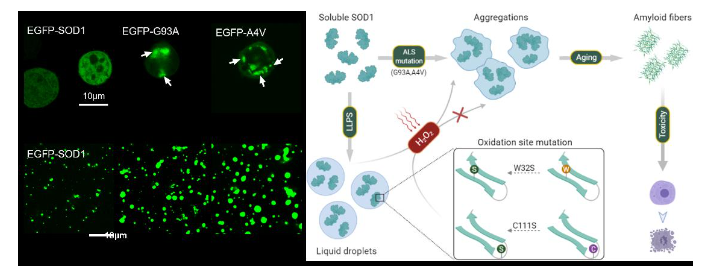In March 2023, the authoritative journal J. Biol. Chem. (2023) online published the latest research achievement of Professor Luo Shizhong from our School of Life Science and Technology, entitled "A liquid-to-solid phase transition of Cu/Zn superoxide dismutase 1 initiated by oxidation and disease mutation". This paper proposes for the first time that liquid-liquid phase separation (LLPS) represents a biophysical process that converts soluble superoxide dismutase 1 (SOD1) into aggregated SOD1. This new discovery provides new theoretical and experimental evidence for the pathogenic mechanism of amyotrophic lateral sclerosis (ALS).

The pathogenic mechanisms of ALS and other neurodegenerative diseases are still unclear. In recent years, Liquid-Liquid Phase Separation (LLPS) has become a new focus in the field of biology. The spatial separation of various cellular proteins and nucleic acids is thought to be closely related to the physiological and pathological processes of several neurodegenerative diseases. The study reveals that SOD1 can undergo LLPS in cells under oxidative stress conditions in vitro. Abnormal oxidation of SOD1 induces the maturation of liquid droplets formed by LLPS, ultimately leading to protein aggregation and fibrillation, which are closely associated with residues Cys111 and Trp32. Pathological mutations in SOD1 associated with ALS (such as A4V, G93A, etc.) alter the morphology and physical state of droplets, promoting the transition of SOD1 droplets to oligomers. Amyloid-like aggregates formed by these two pathways exhibit significant toxic effects on neuronal cells. This study, for the first time, elucidates the pathogenesis of ALS at the level of SOD1 LLPS, enriching our understanding of the pathogenic mechanisms of neurodegenerative diseases and laying the foundation for the development of relevant drugs in the future.

Beijing University of Chemical Technology Professor Luoshi Zhong from the Institute of Life Science and Technology is the corresponding author of this article, with master students Gu Siyu and Xu Ming as co-first authors, and Beijing University of Chemical Technology as the first completion unit of the paper. This research work received strong support from the National Natural Science Foundation and the Ministry of Science and Technology's National Key Research and Development Program.
Article link: https://doi.org/10.1016/j.jbc.2022.102857(DOI:10.1016/j.jbc.2022.102857)


